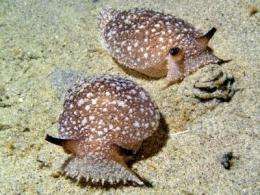Attack or retreat? Circuit links hunger and pursuit in sea slug brain

If you were a blind, cannibalistic sea slug, living among others just like you, nearly every encounter with another creature would require a simple cost/benefit calculation: Should I eat that, do nothing or flee?
In a new study, researchers report that these responses are linked to a simple circuit in the brain of the sea slug Pleurobranchaea. A heightened state of excitation in the neurons that control the animal's attack and feeding behavior means it is hungry and will go for nearly anything that smells like food, the researchers found. Lower activity in the same neurons means the animal is satiated and will do nothing, or will turn away from the smell of other creatures, most likely to avoid becoming food.
"The question was, how does this animal, a predatory forager, make a decision?" said Rhanor Gillette, a University of Illinois molecular and integrative physiology professor who conducted the study with graduate student Keiko Hirayama. "And after some work it became clear that they do it pretty much like you and I. They make decisions not so much on the basis of information, per se, but on the basis of how information makes them feel."
Like most animals, sea slugs must integrate their internal state – how hungry they are – with information from their senses (Does this thing smell good? Is it bigger than me?) and memory (What happened last time I encountered something like this?), Gillette said.
Sea slugs have a very primitive nervous system, but they quickly figure out what not to eat, he said. For evidence of this, he has a video of an encounter between an inexperienced Pleurobranchaea and another sea slug species, Flabellina iodinea, which produces a noxious chemical in its tissues to ward off predators. (Watch it below.) Thirty minutes after this encounter, the researchers put the two together again and Pleurobranchaea steered clear of F. iodinea.
"This is an example of one-trial learning," Gillette said. "This is the one trick it's really good at: learning what to eat or not. Pleurobranchaea is evaluating the odor and estimating risk."
Only "an insanely hungry" animal will attack an unpleasant or painful stimulus, such as an electric shock or the learned, unpleasant taste of F. iodinea, Gillette said.
The researchers focused on the sea slug's approach/avoidance behavior when it catches a whiff of another sea creature (in the lab, the researchers use the amino acids glycine and trimethylglycine, "the essence of seafood," Gillette said). A hungry animal turns toward the stimulus; a satiated animal turns away or does nothing. By turning away, it avoids possible attack by another predator, Gillette said. No response "means that the estimated value of the stimulus is not worth the effort of an attack," he said.
Hirayama found that the sea slug's central nervous system (CNS), even when removed from the animal and placed in a dish, responds to a sensory stimulus as it had in the intact animal. If the brain of a hungry animal detects the odor of food, the neurons that control movement will fire as if turning the animal towards the stimulus. The CNS of a satiated animal will "turn away" from the side of the stimulated nerve.
"Then Hirayama found that nervous systems from very hungry animals had higher levels of spontaneous activity than those that were not hungry," Gillette said. The neurons involved in biting or extending the proboscis – the sea slug's feeding apparatus – appeared to be ready for action. And if the researcher artificially enhanced activity in the neural circuit that controls feeding, "she could change an avoidance turn to an orienting turn," Gillette said.
Hirayama and Gillette think that they have identified a very simple and general type of circuit for cost/benefit decisions, one that is at the core of the more complicated valuations and decisions that are made by the social, higher vertebrates like ourselves. More research into this circuitry could lead to the development of better digital personal assistants and Internet avatars, Gillette said. These findings also may help those studying various kinds of addictions or other extreme, reward-seeking behaviors.
"What we're talking about is a fundamental economic decision of resource acquisition or avoidance," he said. "This basic type of decision is subverted in substance abuse, in illogical gambling and in badly managed shopping, for example. This is why I think that studying the basis of this type of decision in a very simple animal, where we can work it out, is important."
The National Science Foundation and National Institutes of Health supported this research.
The study appears in the journal Current Biology.
Provided by University of Illinois at Urbana-Champaign















